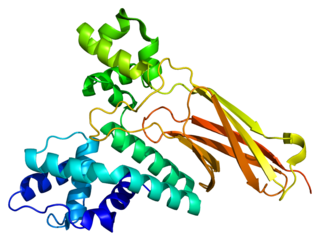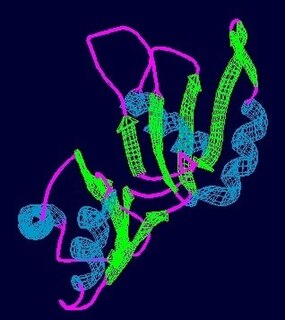U6 snRNA-associated Sm-like protein LSm1 is a protein that in humans is encoded by the LSM1 gene. [4] [5] [6]
U6 snRNA-associated Sm-like protein LSm1 is a protein that in humans is encoded by the LSM1 gene. [4] [5] [6]
Sm-like proteins were identified in a variety of organisms based on sequence homology with the Sm protein family (see SNRPD2). Sm-like proteins contain the Sm sequence motif, which consists of 2 regions separated by a linker of variable length that folds as a loop. The Sm-like proteins are thought to form a stable heteromer present in tri-snRNP particles, which are important for pre-mRNA splicing. [6]

In molecular biology, LSm proteins are a family of RNA-binding proteins found in virtually every cellular organism. LSm is a contraction of 'like Sm', because the first identified members of the LSm protein family were the Sm proteins. LSm proteins are defined by a characteristic three-dimensional structure and their assembly into rings of six or seven individual LSm protein molecules, and play a large number of various roles in mRNA processing and regulation.

Probable ATP-dependent RNA helicase DDX20, also known as DEAD-box helicase 20 and gem-associated protein 3 (GEMIN3), is an enzyme that in humans is encoded by the DDX20 gene.

U5 small nuclear ribonucleoprotein 200 kDa helicase is an enzyme that in humans is encoded by the SNRNP200 gene.

Small nuclear ribonucleoprotein F is a protein that in humans is encoded by the SNRPF gene.

mRNA-decapping enzyme 2 is a protein that in humans is encoded by the DCP2 gene.

U6 snRNA-associated Sm-like protein LSm6 is a protein that in humans is encoded by the LSM6 gene.

U6 snRNA-associated Sm-like protein LSm5 is a protein that in humans is encoded by the LSM5 gene.

U6 snRNA-associated Sm-like protein LSm4 is a protein that in humans is encoded by the LSM4 gene.

U6 snRNA-associated Sm-like protein LSm3 is a protein that in humans is encoded by the LSM3 gene.

U6 snRNA-associated Sm-like protein LSm7 is a protein that in humans is encoded by the LSM7 gene.

U6 snRNA-associated Sm-like protein LSm2 is a protein that in humans is encoded by the LSM2 gene.

mRNA-decapping enzyme 1A is a protein that in humans is encoded by the DCP1A gene.

40S ribosomal protein S20 is a protein that in humans is encoded by the RPS20 gene.

U6 snRNA-associated Sm-like protein LSm8 is a protein that in humans is encoded by the LSM8 gene.

Apolipoprotein B mRNA editing enzyme, catalytic polypeptide-like 3A, also known as APOBEC3A, or A3A is a gene of the APOBEC3 family found in humans, non-human primates, and some other mammals. It is a single-domain DNA cytidine deaminase with antiviral effects. While other members of the family such as APOBEC3G are believed to act by editing ssDNA by removing an amino group from cytosine in DNA, introducing a cytosine to uracil change which can ultimately lead to a cytosine to thymine mutation, one study suggests that APOBEC3A can inhibit parvoviruses by another mechanism. The cellular function of APOBEC3A is likely to be the destruction of foreign DNA through extensive deamination of cytosine.Stenglein MD, Burns MB, Li M, Lengyel J, Harris RS. "APOBEC3 proteins mediate the clearance of foreign DNA from human cells". Nature Structural & Molecular Biology. 17 (2): 222–9. doi:10.1038/nsmb.1744. PMC 2921484. PMID 20062055.

U7 snRNA-associated Sm-like protein LSm10 is a protein that in humans is encoded by the LSM10 gene.

Probable DNA dC->dU-editing enzyme APOBEC-3B is a protein that in humans is encoded by the APOBEC3B gene.

Probable ATP-dependent RNA helicase DDX23 is an enzyme that in humans is encoded by the DDX23 gene.

Probable DNA dC->dU-editing enzyme APOBEC-3D is a protein that in humans is encoded by the APOBEC3D gene.

Prp24 is a protein part of the pre-messenger RNA splicing process and aids the binding of U6 snRNA to U4 snRNA during the formation of spliceosomes. Found in eukaryotes from yeast to E. coli, fungi, and humans, Prp24 was initially discovered to be an important element of RNA splicing in 1989. Mutations in Prp24 were later discovered in 1991 to suppress mutations in U4 that resulted in cold-sensitive strains of yeast, indicating its involvement in the reformation of the U4/U6 duplex after the catalytic steps of splicing.